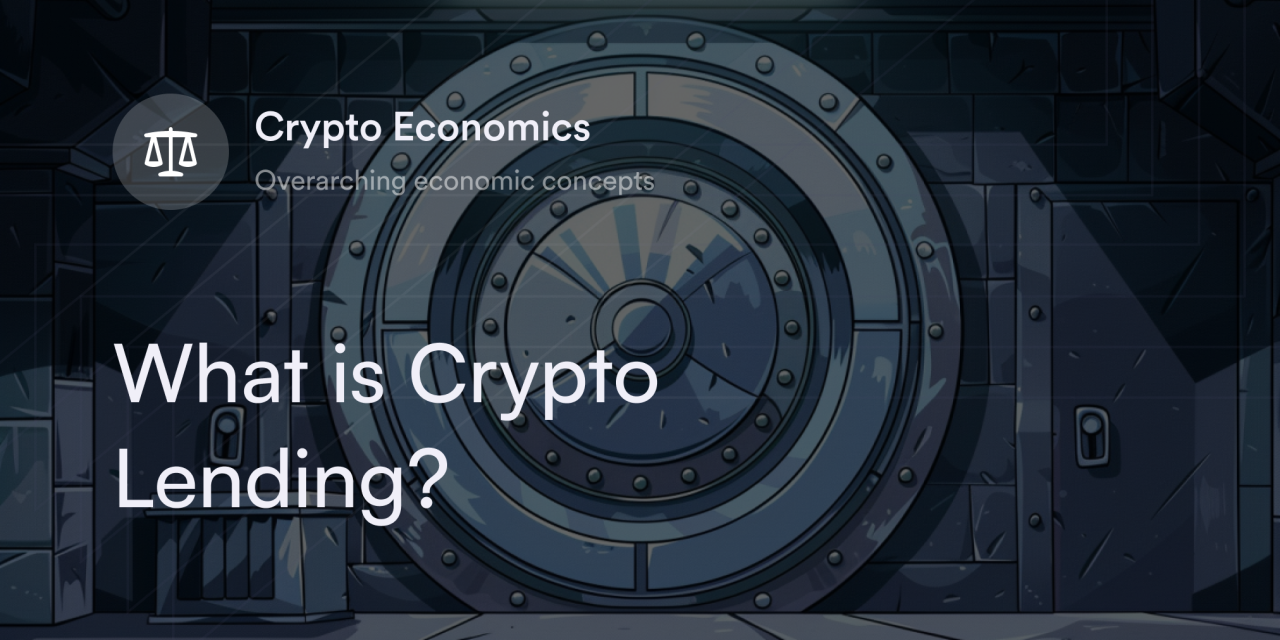


Banks offer dozens of financial services to clients, but borrowing and lending money are their essential features. For most of modern history, the only option people had to borrow funds was to apply for a loan through a centralized financial institution. Thanks to cryptocurrencies, however, more people have access to loans outside the traditional banking infrastructure.
Although using crypto for loans is a new phenomenon, it's causing a significant shift in how people think about borrowing and lending money, due to cryptocurrency’s decentralized properties. Learn what crypto lending is and how it differs from standard lending at a bank or credit union. Plus, discover the benefits and drawbacks of borrowing or lending with crypto assets.
What is Crypto Lending?
Crypto lending means depositing cryptocurrencies for others to borrow. A crypto lender may send digital assets, such as Bitcoin (BTC) or Ethereum (ETH), to a protocol supporting crypto lending and borrowing. Once a lender's cryptocurrencies successfully transfer to the protocol, borrowers can lend these virtual coins or tokens.
Although every crypto lending protocol has different terms, most require borrowers to repay the cryptocurrency they borrowed plus interest within a predefined period. Lenders collect an interest fee in their accounts for as long as they keep their cryptocurrency in a borrowing protocol.
How does Crypto Lending Work?
Cryptocurrency lending is different from centrally controlled lending by traditional financial institutions because it is typically non-custodial, and often provided by decentralized applications (dApps) on blockchains, such as Ethereum. Instead of relying on companies to monitor loan activity, these crypto lending dApps use automated programs called smart contracts to verify transactions and balances on the blockchain. People using decentralized lending sites, such as Aave, link a crypto wallet to deposit or withdraw cryptocurrencies. Transactions on crypto lending dApps typically occur peer to peer.
While decentralized lending is growing in the crypto ecosystem, some centralized companies, such as Coinbase, also offer crypto lending services. These businesses work like traditional banks, but they focus on cryptocurrencies rather than fiat currencies.
Before approving an account, centralized crypto lenders typically collect personal data from customers, such as their name, phone number, and home address. Once people sign up on a centralized crypto lending service, they can deposit accepted digital funds to collect interest or put down collateral for a loan. The company running a centralized crypto lending service is the intermediary for all loan activity on its platform.
Lending platforms use a formula called loan-to-value (LTV) to determine how much a borrower can borrow. Here’s the formula to calculate a crypto loan’s LTV:
LTV as a percentage = (loan amount ÷ collateral) x 100
For example, if a borrower deposited $10,000 worth of crypto collateral into a loan with an LTV of 20%, the loan amount would be $2,000.
Once a borrower takes out a crypto-backed loan, they must keep their collateral percentage above a minimum threshold. This is called the minimum margin requirement, which highlights the dollar value a borrower needs to maintain in their account before a platform sells off their collateral––called liquidation.
Suppose the margin requirement for the above loan was 85%. Here, the borrower must always have at least $8,500 worth of crypto in their collateral balance. If the crypto market dips and a borrower's collateral falls below $8,500, the loan issuer sends a margin call. At this point, the borrower needs to add more funds to increase their collateral or risk liquidation.
Types of Crypto Loans
Each crypto loan platform has unique options and stipulations for lenders and borrowers, including unique LTV ratios, interest rates, and loan repayment timeframes. However, most crypto loans fall into a few broad categories.
What are Overcollateralized Crypto Loans?
With an overcollateralized loan, borrowers need to put more crypto into their collateral account than the funds they want to take out. Crypto lending sites often use overcollateralization to minimize default risks. Since the collateral in these accounts exceeds the requested loan, it gives borrowers more protection should the market price of their deposited cryptocurrency collateral fall. Although margin call and liquidation risks persist, overcollateralized positions mitigate that risk substantially.
What is Margin Lending in Crypto?
Some crypto exchanges offer margin trading to let traders borrow funds to increase their position size. Similar to other crypto loans, traders need a minimum amount of money (or margin requirement) in their accounts to take out and maintain a margin position.Professional traders can use margin trading to increase their market exposure.
What are Crypto Flash Loans?
A flash loan is a high-risk decentralized finance (DeFi) service in which the borrower takes out crypto without putting down collateral. Instead of using overcollateralization or margin requirements, a flash loan provider requires borrowers to repay their debt almost immediately after taking it out (hence, "flash"). Often, traders use flash loans to exploit small price discrepancies in the same cryptocurrency across multiple exchanges––called arbitrage trading.
Pros and Cons of Crypto Loans
Crypto loans address some of the inefficiencies of traditional bank loans, but digital currency is a risky collateral. Assess crypto lending sites’ benefits and drawbacks before depositing funds.
Pros
Competitive crypto lending rates: Long-term investors who lend their digital assets to crypto loan sites enjoy passive income thanks to regular interest payments. From the borrower's perspective, a crypto loan site may offer more attractive borrowing rates than a bank.
No credit checks involved: To take out a loan on a crypto lending site, people only need to deposit the agreed-upon collateral percentage and repay their interest. And borrowers don’t need a minimum credit score or debt-to-income ratio to qualify for a loan.
Immediate funding: Since there's no paperwork involved in reviewing crypto loans, borrowers often receive their requested funds in seconds. On DeFi platforms, the borrowed crypto goes straight into a user's linked self-custodial wallet.
Cons
Crypto volatility increases default risk: Cryptocurrencies often have large price fluctuations. People who use a cryptocurrency such as Ethereum as their collateral face a greater liquidation risk should ETH's price fall lower than the required margin on their loan platform.
Many sites rely on overcollateralization: Due to volatile cryptocurrency prices, many crypto loan issuers only offer overcollateralized loans. In other words, borrowers must take out less than the collateral they put into their accounts. While this prevents loan default risk, it limits the amount of capital borrowers can access.
No insurance: Cryptocurrencies are not federally backed assets, and crypto lenders don’t qualify for insurance protections, such as that offered by the Federal Deposit Insurance Corporation (FDIC). If a centralized crypto lender goes out of business or a hacker breaks into a decentralized lending pool, borrowers and lenders may lose their money.
How to get a Crypto Loan
Taking out a crypto loan varies from site to site, but most follow a similar setup process. Here’s how to get a crypto loan:
Create an account on a lending platform: First, find a company, exchange, or dApp offering crypto loan services. Closely look at each site's LTV ratios, interest payments, accepted crypto collateral, and margin requirements to find a suitable option. If interested in a centralized lending site, submit know-your-customer (KYC) info such as a driver's license, selfie, and home address to the website. For decentralized lending sites, such as Aave, link a compatible self-custodial crypto wallet.
Select loan type and amount: Find an available cryptocurrency loan on a crypto lending platform. Review the repayment responsibilities and margin requirements to avoid getting a margin call.
Deposit collateral and receive funds: Besides uncollateralized flash loans, add your required crypto collateral to receive your newly borrowed digital funds. Once the platform receives the crypto collateral, it immediately sends the borrowed funds to your account or crypto wallet.
Repay the crypto loan: Lastly, make regular payments on the crypto loan until it's fully repaid. Pay attention to the margin threshold and add more collateral if the LTV ratio is near the max limit on this trading platform.
Crypto Lending vs. Staking
Although crypto lending shares a few features with crypto staking, these services differ. Instead of lending cryptocurrency to borrowers, stakers lock a set cryptocurrency amount on a blockchain to secure the network. Virtual currencies using a consensus algorithm called proof-of-stake (PoS) require blockchain validators to put their digital currency on the blockchain to verify transactions. Whenever a validator records new cryptocurrency transactions, they receive crypto rewards in their wallet.
While crypto lenders and stakers receive payment for locking their cryptocurrency on a protocol, a PoS blockchain won't lend this crypto to others and collect interest. Instead, a cryptocurrency's consensus protocol automatically generates rewards and redistributes them to network participants.
Learn More About Crypto on dYdX
Lending and borrowing with cryptocurrency open new doors for many investors, but not without risks.
Head to the dYdX Academy to continue learning about the crypto universe. dYdX has dozens of educational articles on various aspects of crypto and blockchain. Also, check out dYdX's blog to learn more about us and our decentralized exchange.
Start trading on dYdX today!
Disclaimer
The content of this article (the “Article”) is provided for general informational purposes only. Reference to any specific strategy, technique, product, service, or entity does not constitute an endorsement or recommendation by dYdX Trading Inc., or any affiliate, agent, or representative thereof (“dYdX”). Use of strategies, techniques, products or services referenced in this Article may involve material risks, including the risk of financial losses arising from the volatility, operational loss, or nonconsensual liquidation of digital assets. The content of this Article does not constitute, and should not be considered, construed, or relied upon as, financial advice, legal advice, tax advice, investment advice, or advice of any other nature; and the content of this Article is not an offer, solicitation or call to action to make any investment, or purchase any crypto asset, of any kind. dYdX makes no representation, assurance or guarantee as to the accuracy, completeness, timeliness, suitability, or validity of any information in this Article or any third-party website that may be linked to it. You are solely responsible for conducting independent research, performing due diligence, and/or seeking advice from a professional advisor prior to taking any financial, tax, legal, or investment action.
You may only use the dYdX Services in compliance with the dYdX Terms of Use available here, including the geographic restrictions therein.
Any applicable sponsorship in connection with this Article will be disclosed, and any reference to a sponsor in this Article is for disclosure purposes, or informational in nature, and in any event is not a call to action to make an investment, acquire a service or product, or purchase crypto assets. This Article does not offer the purchase or sale of any financial instruments or related services.
By accessing this Article and taking any action in connection with the information contained in this Article, you agree that dYdX is not responsible, directly or indirectly, for any errors, omissions, or delays related to this Article, or any damage, injury, or loss incurred in connection with use of or reliance on the content of this Article, including any specific strategy, technique, product, service, or entity that may be referenced in the Article.







